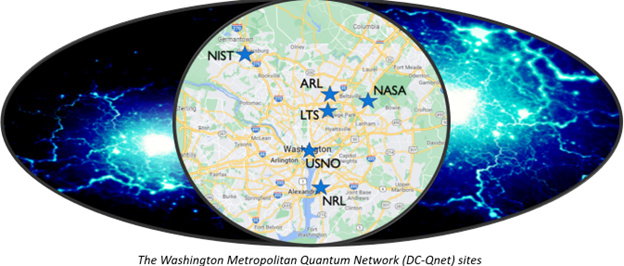
NIST’s Abdella Battou and Thomas Gerrits presented recommendations to the Defense Advanced Research Project Agency (DARPA) for improving the Washington Metropolitan Quantum Network, or DC-QNet. The U.S. Government created DC-QNet to serve as a testbed for demonstrating secure communications. DC-Net consists of six sites which are operated by the Army Research Laboratory (ARL), Naval Research Laboratory (NRL), U.S. Naval Observatory (USNO), National Institute of Standards and Technology (NIST), Laboratory for Telecommunication Sciences (LTS), and National Aeronautics and Space Administration (NASA).
The recommendations were developed by a team of representatives from the Army Research Laboratory, Laboratory for Telecommunication Sciences, Naval Research Laboratory, National Aeronautics and Space Administration, NIST, and the University of Pennsylvania.
Battou and Gerrits’ team addressed the following regarding DC-QNet:
- Improving Connectivity: DC-QNet’s six sites are connected by fiber pairs. Battou and Gerrits recommended increasing the number of fiber pairs between sites and upgrading optical switching.
- Enabling Time synchronization: Presently, DC-QNet needs a permanent baseline time synchronization capability. Experiments have shown commercial technology to be adequate. Battou and Gerrits recommended use of commercial time synchronization equipment achieving sub-nanosecond precision until a better solution emerges.
- Improving management of experiments on DC-QNet: This management is done using “Multiverse” software – a software suite developed by NIST, which enables testing and routing of quantum entanglement in realistic conditions on DC-QNet. Battou and Gerrits recommended improving the functionality and security of Multiverse.
- Increasing Wavelength Flexibility: DC-QNet connectivity limitations are seen when running multiple experiments concurrently. Battou and Gerrits recommended upgrading to wavelength switching to allow for simultaneous transmission and routing of quantum bits through to many users using the same long-haul fibers.
- Adding Fiber Characterization Capabilities: Fiber-link characterization is paramount for the successful transmission of quantum information in metropolitan-scale fiber networks. Currently, DC-QNet cannot automatically perform several of these needed characterizations. While research is on the way to investigate many different options on fiber characterization, based on quantum signals, Battou and Gerrits recommended using a commercially available solution to fully automate fiber characterization with classical signals.

